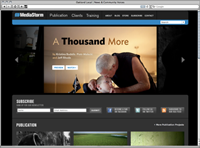The industry is paying attention. In 2010, “Intended Consequences”, a MediaStorm documentary about the rape victims of Rwandan violence in the 1990s, became the first web-based project to win a duPont-Columbia University Award for excellence in broadcast (and now digital) news. MediaStorm takes its time with its projects: “Driftless” is a production that came out of photographer Danny Wilcox Frazier’s five-year exploration of Iowan farms; he had so much material that it was in post-production for a year.
MediaStorm does not publish very frequently by web standards, but when it does, it gets noticed. The organizations wide following makes it an attractive place for photographers and filmmakers to bring their work. “Driftless,” for instance, was produced from material that Frazier had collected for a book project. As founder and executive producer Brian Storm put it, why cover a topic for five years and then just sell a few thousand copies of a book, when you can have 40,000 people watching your MediaStorm piece on the first day it’s up, as Frazier’s video had? MediaStorm pays all of its contributors a licensing fee, and offers a percentage of the revenue that the outlet gets from syndicating the work elsewhere.
The publication side of MediaStorm gets the organization credentials and exposure, but the company earns the large majority of its revenue through consulting, production work for clients, and training; its producers and engineers work with corporate clients, NGOs, and media outlets to help them tell their stories.
Storm, who first founded the company in 1994 while a journalism student at the University of Missouri, has seen firsthand the difficulties newsrooms have had in addressing the growing appetite for multimedia online. As a consultant, he says he watched managers in news organizations get enamored with the idea of video, without necessarily giving their staff the resources or training to produce it well. Trained photographers were told to put down their still cameras and pick up new video cameras, go out and shoot video, and put it up online quickly. The result was often expensive but low-quality video that no one watched.
“So that process was sort of maddening to watch, because it was sort of clear to me that it was going to fail before it even got off the ground, it was just too expensive and no one had any training–it was just set up to fail,” says Storm.
FlipCam videos are great for breaking news stories, of course, but if you want to produce documentary short features that people will take the time to watch and want to share with their friends, quality matters. So the method that Storm recommends for multimedia novices is to collect a combination of still photographs and audio interviews, and put together an audio slideshow. It’s cheaper, it’s faster, and it can be extremely effective.
“Now I’ve seen a bit of a pull back, people realize that video is really hard to do, and it takes a lot of time to do well,” he says. “And it’s only the stuff that you do well that really matters.”
MediaStorm continues to grow its business model, and is always keeping an eye out for new sources of revenue. The bulk of the company’s profit still comes from consulting and producing gigs with clients, according to Storm. But workshops, seminars, and licensing and selling in-house work to media outlets, also bring in revenue. Recently, the group developed its own video player to license out to media clients–thereby making MediaStorm a software company, an online publication, a production company, and a training center in one.
Storm says that he expects that the training aspect of the company–or “evangelism,” as he calls it–will grow quickly in the years to come. They have offered an intensive course in New York for a while now, where aspiring filmmakers and photographers learn the reporting and production process from start to finish. The work that comes out of these workshops is impressive, but there’s a fairly steep price attached: $3,500 per week.
To make MediaStorm’s brand of training accessible to more people, they now offer online courses–video tutorials which are available in various combinations depending on one’s area of focus, but which cost $200 at most for unlimited yearly access. Storm says the online courses have only been live for a few months, but they have already proven popular. “I would expect our online training stuff to be a really important revenue source over the next few years,” he says.
“We’re just like any freelance journalist that you ever met–we’ve got to have a diverse client base,” says Storm. “We already have a diverse client base, but we’re also trying to diversify where the money comes from.”
 BROOKLYN, NEW YORK — Above the cobblestone streets of Brooklyn’s DUMBO neighborhood, the producers, engineers, and cinematographers of MediaStorm are producing some of the most arresting and moving stories online today. While side-stepping the news cycle in favor of more timeless features, their particular brand of multimedia narrative is attracting online viewers from 170 countries around the globe. It has also helped the company remain self-sustaining and profitable since its current iteration launched in 2005.
BROOKLYN, NEW YORK — Above the cobblestone streets of Brooklyn’s DUMBO neighborhood, the producers, engineers, and cinematographers of MediaStorm are producing some of the most arresting and moving stories online today. While side-stepping the news cycle in favor of more timeless features, their particular brand of multimedia narrative is attracting online viewers from 170 countries around the globe. It has also helped the company remain self-sustaining and profitable since its current iteration launched in 2005.
